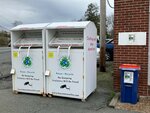Rehoboth Emergency Management Agency Hurricane Safety Tips
Both Tropical Storms (with winds above 39 mph) and Hurricanes (winds above 74 mph) can have deadly coastal storm surge and cause significant damage.
What Are Hurricanes?
Hurricanes are a rotating low-pressure tropical weather system. Systems with maximum sustained surface winds of less than 39 miles per hour (mph) are called tropical depressions. Those with maximum sustained winds of 39 mph or higher are called tropical storms. When a storm's maximum sustained winds reach 74 mph, it is called a hurricane. The Saffir-Simpson Hurricane Wind Scale is a 1 to 5 rating, or category, based on a hurricane's maximum sustained winds. The higher the category, the greater the hurricane's potential for property damage.
Why Prepare?
Hurricanes have the power to cause widespread devastation, and can affect both coastal and inland areas. Threats from hurricanes include:
Storm surge
High winds
Heavy rainfall
Inland flooding
Tornadoes
Rip currents
Although the Atlantic hurricane season is officially June 1 through November 30, the most active time for these storms in Massachusetts is late August through September.
Hurricane & Tropical Storm Watches and Warnings
The National Weather Service issues tropical storm and hurricane watches and warnings to alert the public of potential hazardous conditions. It is important to understand the difference between a watch and a warning so you know what to do to stay safe.
Hurricane & Tropical Storm Watch
Hurricane Watch — Hurricane conditions are possible within the next 48 hours.
Tropical Storm Watch — Tropical storm conditions are possible within the next 48 hours.
Hurricane & Tropical Storm Warning
Hurricane Warning — Sustained winds ≥ 74 mph associated with a hurricane are expected to affect a specified area within 24 hours.
Tropical Storm Warning — Sustained winds of 39–73 mph associated with a tropical storm are expected to affect a specified area within 24 hours.
What to do before a Hurricane Strikes
Be informed by receiving alerts, warnings, and public safety information before, during, and after emergencies. Download the Massachusetts Alerts App.
Know Your Zone. Learn if you live in a hurricane evacuation zone.
Find out whether your property is in a flood-prone or high-risk area. Explore the Federal Emergency Management Agency’s (FEMA) flood maps.
Create and review your family emergency plan.
If you live or work in a flood zone, hurricane evacuation zone, or an area that is prone to flooding, you should be prepared to evacuate.
If you receive medical treatment or home health care services, work with your medical provider to determine how to maintain care and service if you are unable to leave your home or have to evacuate during.
Assemble an emergency kit
Follow instructions from public safety officials.
Prepare for possible power outages.
Ensure your smoke and carbon monoxide detectors are working and have fresh batteries.
Consider purchasing a generator to provide power during an outage. Follow the manufacturer’s instructions and learn how to use it safely before an outage.
If you have life-support devices or other medical equipment or supplies which depend on electricity, notify your utility and work with your medical provider to prepare for power outages.
Make a record of your personal property by taking photos or videos of your belongings. Store these records in a safe place.
Prepare your home.
Consider attaching temporary plywood covers to protect windows and sliding doors.
If you live in a coastal community, review the Homeowner's Handbook to Prepare for Coastal Hazards
Flood losses are not typically covered under renter and homeowner’s insurance policies. Consider purchasing flood insurance through the National Flood Insurance Program (NFIP).
What to do when a Hurricane or Topical Storm Is Approaching
Listen to a National Oceanic and Atmospheric Administration (NOAA) Weather Radio or to a local news station for the latest information.
Review your family emergency plan.
If you live or work in a flood or or an area that is prone to flooding, be ready to evacuate.
If you are not in an area prone to flooding and planning on riding out the storm at home, gather adequate supplies in case you lose power and water for several days and you are unable to leave due to.
Prepare for power outages by charging cell phones and electronics and setting your refrigerator and freezer to their coldest settings. If you use electricity to get well water, fill your bathtub with water to use for flushing toilets.
Keep your car’s gas tank full. Pumps at gas stations may not work during a power outage.
Prepare your home.
Secure or bring in outdoor objects (patio furniture, children's toys, trash cans, etc.) that could be swept away or damaged during strong winds or flooding.
Clear clogged rain gutters to allow water to flow away from your home.
If damaging winds are expected, cover all of your windows. If you don’t have storm shutters, board up windows with 5/8” exterior-grade or marine plywood.
Go Tapeless! Taping windows wastes preparation time, does not stop windows from breaking in a hurricane, and does not make cleanup easier. In fact, taping windows may create larger shards of glass that can cause serious injuries.
Turn off propane tanks if you are not using them.
Prepare for flooding by elevating items in your basement, checking your sump pump, unplugging sensitive electronic equipment, clearing nearby catch basins, and parking vehicles in areas not prone to flooding.
If instructed, turn off your gas and electricity at the main switch or valve.
If you have a boat, remove it from the water. If you cannot, prepare your boat for the storm to reduce damage.
What to do during a Hurricane
Avoid driving or going outdoors during a storm. Flooding and damaging winds can make traveling dangerous.
If you must be out in the storm:
Do not walk through flowing water. Six inches of swiftly moving water can knock you off of your feet.
Remember the phrase “Turn Around, Don’t Drown!” Don’t drive through flooded roads. Cars can be swept away in just two feet of moving water. If your vehicle is trapped in rapidly moving water, stay in the vehicle. If the water is rising inside the vehicle, seek refuge on the roof.
Do not drive around road barriers.
Continue to monitor media for emergency information.
Follow instructions from public safety officials.
If advised to evacuate, do so immediately. Take only essential items, and bring your pets if possible.
If told to shelter in place:
Stay indoors and away from windows.
Listen to local television or radio for updates.
Conditions may change quickly; be prepared to evacuate to a shelter or neighbor’s home if necessary.
















Comments
No comments on this item Please log in to comment by clicking here